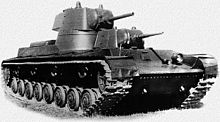SMK (tank)
The SMK was a prototype of a Soviet heavy tank .
From 1932, development work began on a whole series of super-heavy tanks in the Soviet Union.
In 1938, a third generation of heavy tanks was to be developed to replace the T-35 . Two groups of engineers started the development: While the OKMO collective produced the T-100 "Sotka", the team around Lieutenant Colonel Kotin constructed the SMK (named after SM Kirov ). While the military's original requirement called for a five-tower tank, the design teams unanimously opposed such a design. Even before the project started, the project could be limited to three towers. After the first presentations, the decision was made to further reduce the number of towers.
In the end, the two designs looked very much alike. The construction of the SMK as well as the T-100 took up the idea of the multi-tower concept, which already determined the development of the T-28 and T-35 . However, the number of towers was reduced to two.
The Kotin engineering team was critical of the concept of the multi-tower tank and was able to develop the SMK as a conventional tank with one tower at the same time. This project led to the prototype of the KW-1 .
The first prototype of the SMK and the KW were completed in August 1939. In September the prototype was sent to Kubinka for testing and was subsequently used in the Finnish War. There the vehicle ran into a mine in use. The German reconnaissance erroneously called the vehicle the T-35C.
Technical specifications
- Crew 7
- Weight 55 t
- Length 8.38 m
- Width 3.3 m
- Height 3.45 m
- Armament
- L-11 76.2mm cannon
- 45mm cannon
- Motor AM-34 with 850 HP
- Speed (road) 36 km / h
- Driving range 150 km
- Armor 20–60 mm
